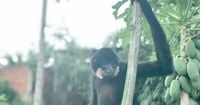On the morning of September 6, 2025, residents of Hamlet 38 in Tan Nhut commune, Ho Chi Minh City, awoke to a scene that was both unusual and heartwarming—a rare yellow-cheeked gibbon, its black fur offset by distinctive golden cheeks, was spotted foraging behind a local home. For nearly ten days, this striking primate had become something of a neighborhood celebrity, frequently seen moving gracefully through the area and accepting fruits and vegetables from curious, compassionate locals.
According to reporting from PLO and Tien Phong, the gibbon’s presence did not go unnoticed. Residents, recognizing the animal as a rare and precious species, promptly contacted local authorities. Despite an initial search by the Forestry Sub-Department of Ho Chi Minh City and local officials, the elusive animal managed to evade capture, only to reappear days later, delighting residents who continued to offer it bananas, cucumbers, and even cakes. It was a small act of kindness, but one that likely helped the animal survive in an unfamiliar environment.
On September 6, after receiving new reports from residents, the Forestry Sub-Department, in coordination with local authorities and the community, implemented a careful plan. Using tranquilizer darts, they were able to safely capture the gibbon and transport it to a facility for care and rehabilitation, in accordance with regulations. Photographs captured during the operation show the animal being gently handled by trained staff, a testament to the coordinated effort between citizens and officials.
Initial assessments identified the animal as a male yellow-cheeked gibbon (Nomascus gabriellae), weighing approximately 3.5 kilograms. This species is classified in group IB of Vietnam’s list of endangered, precious, and rare species, as specified under Circular 27/2025 of the Ministry of Agriculture and Rural Development—now the Ministry of Agriculture and Environment. The yellow-cheeked gibbon is also listed as endangered in Vietnam’s Red Book and by the International Union for Conservation of Nature (IUCN).
The yellow-cheeked gibbon is native to the forests of Vietnam, Laos, and Cambodia. Its most distinctive feature is the dramatic difference in fur coloration depending on age and sex. Newborns are covered in yellow fur, which darkens to black as they grow. Mature males retain their black fur with signature yellow cheeks, while mature females revert to yellow fur, keeping a black patch on the crown of the head. This sexual dimorphism is not just a quirk of nature—it’s a fascinating adaptation that helps researchers and locals alike identify individuals and track their development.
Life in the treetops is the norm for these gibbons. They are masterful brachiators, swinging through the forest canopy with remarkable speed and agility. Family life is equally unique: yellow-cheeked gibbons typically form monogamous pairs, raising their young together for several years before the offspring leave to form their own groups. Social bonds are reinforced not just through grooming and play, but through song. The species is famous for its melodious, far-carrying duets performed at dawn. These songs serve to mark territory and strengthen pair bonds, earning the gibbon the affectionate nickname, "the forest’s lyrical singer."
But the survival of the yellow-cheeked gibbon is far from assured. As highlighted by both PLO and Tien Phong, the species faces mounting threats from deforestation, illegal hunting, and the wildlife trade. Forests across Southeast Asia are shrinking rapidly due to logging, agriculture, and urban expansion, fragmenting the gibbon’s habitat and isolating populations. Poaching remains a persistent danger, with gibbons targeted for use in traditional medicine or sold as exotic pets. Conservationists warn that without urgent action, the haunting songs of the yellow-cheeked gibbon may one day fall silent.
The events of September 6 were not limited to the gibbon’s rescue. On the very same day, the Forestry Sub-Department of Ho Chi Minh City received three langurs voluntarily surrendered by Mr. Lam Dao Trieu, a resident of Chanh Hung ward. The animals—a pig-tailed langur, a red-faced langur, and a long-tailed langur—are all classified as group IIB endangered species under Vietnamese law. Following established procedures, forestry officials tranquilized and received the animals, providing care with the goal of eventually releasing them back into the wild.
Mr. Trieu, speaking to Tien Phong, explained his motivations: "Voluntarily surrendering these animals aims to ensure better care and increase their chances of returning to the natural environment." His decision reflects a growing awareness among the public of the importance of wildlife protection and responsible stewardship.
Officials from the Forestry Sub-Department echoed this sentiment. The successful rescue and care of the gibbon and langurs demonstrate what can be achieved when citizens, local authorities, and conservation experts work together. The collaboration between residents—who not only reported the sightings but also helped sustain the animals with food—and trained professionals was crucial. As one forestry officer put it, "Without the support of the local community, it would have been much more difficult to locate and safely rescue these rare animals."
Vietnam’s legal framework for wildlife protection is robust, but enforcement, education, and public engagement remain key challenges. The case in Tan Nhut commune illustrates the positive impact that informed and proactive citizens can have on conservation outcomes. It also highlights the importance of ongoing education campaigns to help people recognize endangered species and understand the procedures for reporting and surrendering wildlife.
Looking ahead, the rescued yellow-cheeked gibbon and the three langurs will receive specialized care, tailored to their needs, with the hope that they can be rehabilitated and eventually released back into their natural habitats. Their stories serve as a poignant reminder of the resilience of wildlife—and the responsibility shared by all to protect it. As forests shrink and threats multiply, every successful rescue represents not just a victory for conservation, but a reaffirmation of the bond between people and the natural world.
For now, the gibbon’s song will continue, a symbol of hope echoing through the treetops of Vietnam. Whether these animals can one day return to the wild and thrive will depend on the sustained efforts of communities, authorities, and conservationists working hand in hand.




